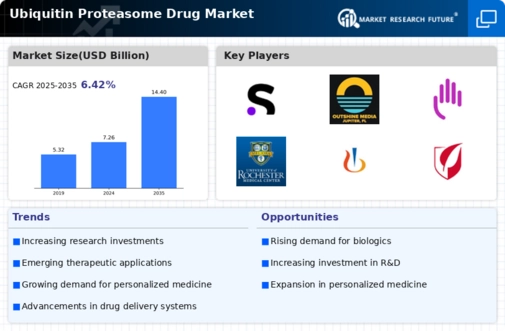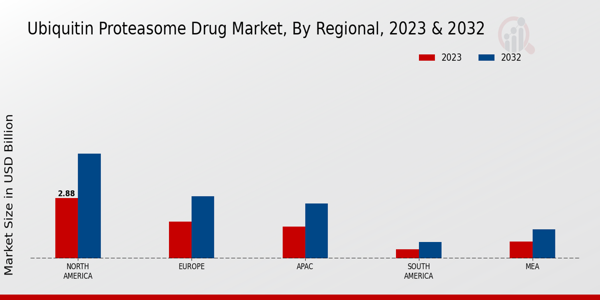Market Growth Projections
The Global Ubiquitin Proteasome Drug Market Industry is projected to experience substantial growth, with estimates indicating a market size of 7.26 USD Billion in 2024 and a potential increase to 14.4 USD Billion by 2035. This growth trajectory suggests a compound annual growth rate of 6.42% from 2025 to 2035. Such projections highlight the increasing demand for proteasome inhibitors as effective cancer therapies. The market's expansion is driven by factors such as rising cancer incidence, advancements in drug development, and increased research funding. These elements collectively contribute to a favorable environment for the growth of the ubiquitin proteasome drug market.
Increased Research Funding
The Global Ubiquitin Proteasome Drug Market Industry benefits from increased research funding aimed at understanding the ubiquitin-proteasome pathway. Governments and private organizations are investing heavily in research initiatives to explore the therapeutic potential of proteasome inhibitors. This influx of funding supports clinical trials and the development of new drugs, fostering innovation. For instance, the National Institutes of Health has allocated substantial resources to cancer research, which includes studies on proteasome inhibitors. This financial support is likely to enhance the market's growth, as more effective therapies are developed and brought to market.
Rising Incidence of Cancer
The Global Ubiquitin Proteasome Drug Market Industry is experiencing growth due to the increasing incidence of cancer worldwide. Cancer remains a leading cause of mortality, with millions diagnosed annually. The demand for innovative therapies, particularly those targeting the proteasome pathway, is on the rise. For instance, proteasome inhibitors have shown efficacy in treating multiple myeloma and certain types of lymphoma. As the global population ages, the prevalence of cancer is likely to escalate, thereby driving the market's expansion. The market is projected to reach 7.26 USD Billion in 2024, reflecting a robust response to this pressing health challenge.
Advancements in Drug Development
Innovations in drug development are significantly influencing the Global Ubiquitin Proteasome Drug Market Industry. Recent advancements in biotechnology and pharmacology have led to the creation of more effective proteasome inhibitors. These developments include the identification of novel targets within the ubiquitin-proteasome system, enhancing the specificity and efficacy of treatments. For example, the introduction of next-generation proteasome inhibitors is expected to improve patient outcomes and reduce side effects. As these advancements continue, the market is anticipated to grow, potentially reaching 14.4 USD Billion by 2035, indicating a strong trajectory for future drug development.
Regulatory Support for Novel Therapies
Regulatory bodies are providing support for the development and approval of novel therapies within the Global Ubiquitin Proteasome Drug Market Industry. Streamlined approval processes and incentives for orphan drugs are encouraging pharmaceutical companies to invest in proteasome inhibitors. For example, the FDA has established programs to expedite the review of drugs that address unmet medical needs, particularly in oncology. This regulatory environment fosters innovation and accelerates the availability of new treatments to patients. As a result, the market is poised for growth, with an increasing number of proteasome inhibitors likely to enter the market in the coming years.
Growing Awareness of Targeted Therapies
There is a growing awareness and acceptance of targeted therapies within the Global Ubiquitin Proteasome Drug Market Industry. Healthcare professionals and patients are increasingly recognizing the benefits of treatments that specifically target cancer cells while minimizing damage to healthy tissues. This shift in perception is driving demand for proteasome inhibitors, which are designed to disrupt the cancer cell lifecycle effectively. As educational initiatives and clinical evidence supporting these therapies proliferate, the market is expected to expand. The anticipated compound annual growth rate of 6.42% from 2025 to 2035 underscores the potential for sustained growth in this sector.













